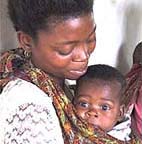|
||||

|
|
|||||||||||||||||||||||||||||||||||||||||||
|
June 2001 Return to June 2001 contents page SPECIAL FEATURE Taking care of tomorrow
Developing countries – and other GAVI partners – are starting to plan how immunization services should be financed beyond 2005. Along the way, they may even be triggering a rethink of the relationships between countries and donors, as Phyllida Brown reports NOT so long ago, Zimbabwe’s immunization programme experienced some of the worst effects of an unsustainable financing scheme. Through a financial loophole in the then-closed economy, international corporations in Zimbabwe could donate money to a non-governmental organization, which increased the proportion of their profits that they could repatriate. For its part, the organization used the donations to buy hepatitis B vaccine for introduction into the national immunization programme. Vaccination began, but, soon after, the law changed and the scheme finished. Vaccine supplies stopped, babies could no longer be immunized against the virus, and many parents mistakenly assumed there was something wrong with the vaccine itself.
No one should be more aware of this responsibility than GAVI and the Vaccine Fund. Their awards to countries are intended as catalysts. The awards last for five years, and the money can be spread over seven if a country chooses. But when the awards run out, countries will need different, sustainable sources of funds. If the GAVI partners – the countries themselves, plus donors, development banks and the international agencies – do not plan sustainable financing for the second half of this decade and beyond, those countries will be no better off – and possibly worse off – than before the awards were made. "If we fail, we will create a vacuum, by starting things and not following on in the longer term," says Steve Landry, from the US Agency for International Development (USAID) and co-chair of the GAVI Financing Task Force. A widening gulf Some developing countries are increasing their investment in health despite difficult economic conditions and severely limited resources (see Box 2). Immunization remains one of the most cost-effective health interventions, and accounts for no more than 5% of the health budget in those countries studied so far, and often much less. As a percentage of those countries’ gross national product, immunization accounts for no more than 0.1%(2). But the costs – as well as the benefits – of immunization must be expected to grow as under-used vaccines and essential improvements, such as higher coverage, a better cold chain and the introduction of auto-disable syringes, are built into national programmes. The gap between what many governments pay for immunization now and what they will need to pay is large – and growing.
In Côte d’Ivoire, for example, a recent study suggested that, by 2003, improvements to the existing national programme and the addition of hepatitis B vaccine would more than double the annual cost of the programme, from under US $4 million to about $9 million(2) (see Figure 1). Figure 1: Closing the gap: the costs of running Côte d’Ivoire’s immunization programme
Given the many competing demands on the health purse, the idea that cash-strapped governments in the poorest countries will be able to finance such services entirely by themselves in the foreseeable future looks increasingly unrealistic. Indeed, the experience of the 1990s had already shown, says Tore Godal, executive secretary of GAVI, that some programmes from which donor support was withdrawn were not sustained. Despite this, some donors and analysts have continued to argue the philosophy that developing countries should move swiftly to achieve self-sufficiency because dependency on donors is undesirable. In the near term, sustainability need not mean self-sufficiency Now, however, fresh thinking has produced proposals for a more realistic way forward. In an analysis(3) commissioned by the GAVI Financing Task Force, Ruth Levine, a health economist at the World Bank, and others, call for a new definition of financial sustainability for developing countries’ immunization programmes. No longer, they argue, need sustainability be considered to be synonymous with self-sufficiency. In current conditions, after all, progress towards self-sufficiency would mean, in effect, a growing "health gap" between rich and poor nations. At this month’s GAVI meeting in Geneva, the participants discussed and endorsed the ideas put forward by Dr Levine and her colleagues. The participants proposed that: "Although self sufficiency is the ultimate goal, in the nearer term sustainable financing is the ability of a country to mobilize and efficiently use domestic and supplementary external resources on a reliable basis to achieve target levels of immunization performance*."
"The challenge is fundamentally a political one," says Dr Levine. For, despite the growing costs of wider immunization, the absolute amounts of money involved are small relative to other health interventions. "The resources are there," says Dr Levine, "both in countries and in the international community. Compared with many other health interventions, arguing the case for immunization is really easy – even when you add the new vaccines such as hepatitis B and Hib this is not actually a lot of money." Dr Levine points to countries such as Honduras, and Bolivia (Box 3), whose political commitment to immunization can only be envied by most industrialized countries.
New thinking for donors, too The new definition also challenges donors to update their roles. In a global economy, the benefits of immunization cross borders. So, out of self-interest as well as a concern for people’s welfare, it makes sense for richer countries to invest in the health of poorer ones. Evidence is mounting that better health is a key step to reducing poverty in the poorest economies. To ensure sustainable support, donors could be asked to commit themselves in writing to a certain number of years. If there is to be a genuine collaboration, donors who are used to setting targets for the countries they support could even agree to meet certain targets themselves so that responsibility is evenly shared. But definitions are just definitions. What difference will a new definition make? Potentially, a lot. After delegates at the Geneva meeting supported the broader definition of sustainability, it is now being put to the GAVI Board. If GAVI policy is built round the new definition, it could give governments in developing countries more flexibility about how to approach their plans for sustainable financing – and it could also mean that donors become more engaged in those plans. If all parties use the planning process as a real opportunity, rather than a bureaucratic exercise, says Dr Levine, real progress can be made.
So what do the donors themselves think about the new thinking on sustainability? Immunization Focus approached officials in several donor agencies. Those who responded were generally positive. Norway, which last year committed $125 million to GAVI, has long believed in long-term investment in countries. Its programmes with countries typically last at least 10-15 years, says Rune Lea, health adviser in the Norwegian Agency for Development Cooperation. The aim is to invest in human capital, through health and education, as a way to build each country’s capacity towards eventual self-sufficiency. Dr Lea warns that a truly sustainable immunization programme will need to be planned within the overall health system’s framework, but is broadly supportive of the arguments put forward by Dr Levine and her colleagues. For the US, too, there is increasing recognition that the long-haul approach makes sense, although no one imagines it will be easy to achieve. "We acknowledge that this is the way it is going to have to be, because there are no reasonable alternatives in the short term," says Steve Landry at USAID. It will mean that donor agencies’ staff at country level, who serve on Interagency Coordinating Committees, will engage more actively than before as real partners with the government. "The whole concept of the ICC is that now all the partners are sharing some responsibility for the function of the programme, in explicit terms, and they have to engage on a routine basis in working with the government to take this on." In other words, the future of immunization is everyone’s responsibility. References: (1) Immunization Finance Sustainability Plans. Workshop 4-6 June 2001, Geneva, hosted by WHO, cosponsored by USAID and the Bill and Melinda Gates Children’s Vaccine Program at PATH. (2) Kaddar, Miloud, Ann Levin, Leanne Dougherty and Daniel Maceira. May 2000. Costs and Financing of Immunization Programs: Findings of Four Case Studies. Special Initiatives Report 26. Bethesda, MD: Partnerships for Health Reform Project, Abt Associates www.VaccineAlliance.org/financing/pdf/ four_country.pdf (3) Levine, Ruth, Magdalene Rosenmöller, and Peyvand Khaleghian. April 2001. Financial Sustainability of Childhood Immunization: Issues and Options. Commissioned by the GAVI Financing Task Force www.VaccineAlliance.org/reference/fsci_execsumm.html (4) Tambini, G. presentation at (1) and Annex, Project Appraisal Department, Phase II – Bolivia Health Sector Reform Project, World Bank; can be viewed on PAHO site in EPI Newsletter at www.paho.org/English/HVP/HVI/sne2302.pdf *NOTE: "Immunization performance" is defined in terms of current and future goals for access, utilization, quality, safety and equity.
Phyllida Brown
Return to June 2001 contents page
|
|||||||||||||||||||||||||||||||||||||||||||
| Contact GAVI | Guestbook | Text version | Credits and Copyright
|
|||||||||||||||||||||||||||||||||||||||||||



